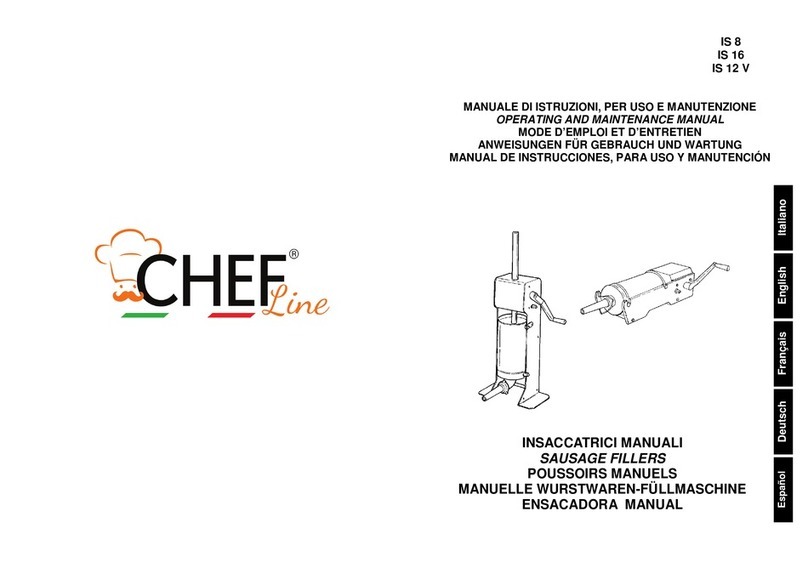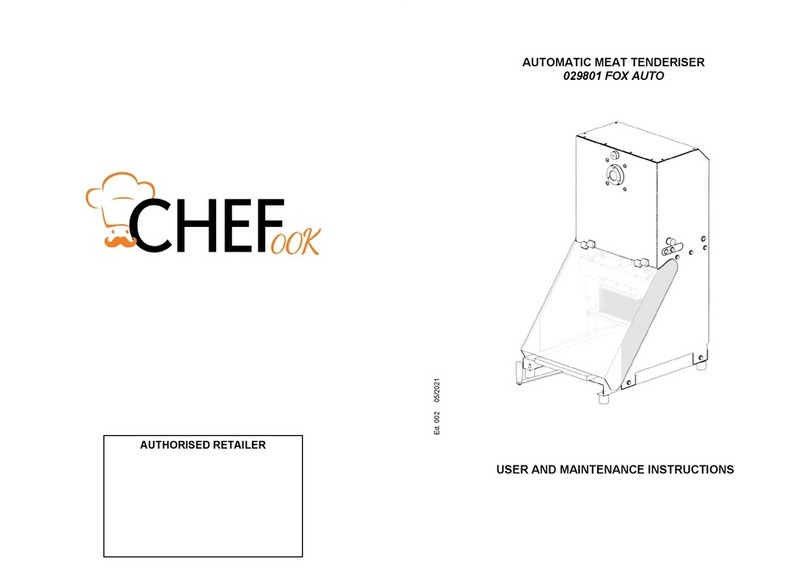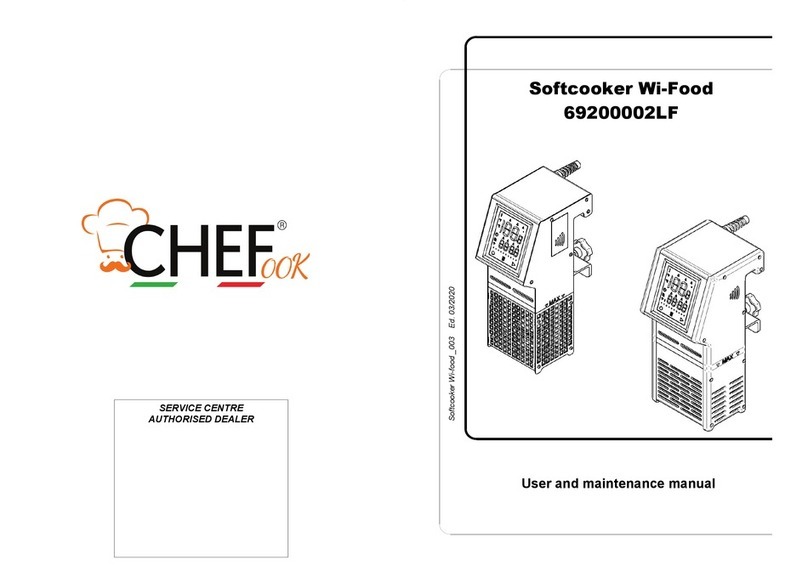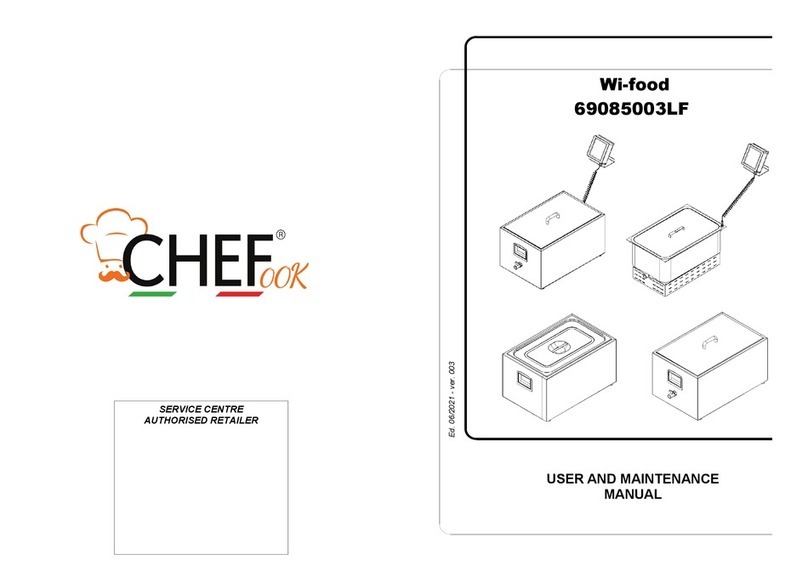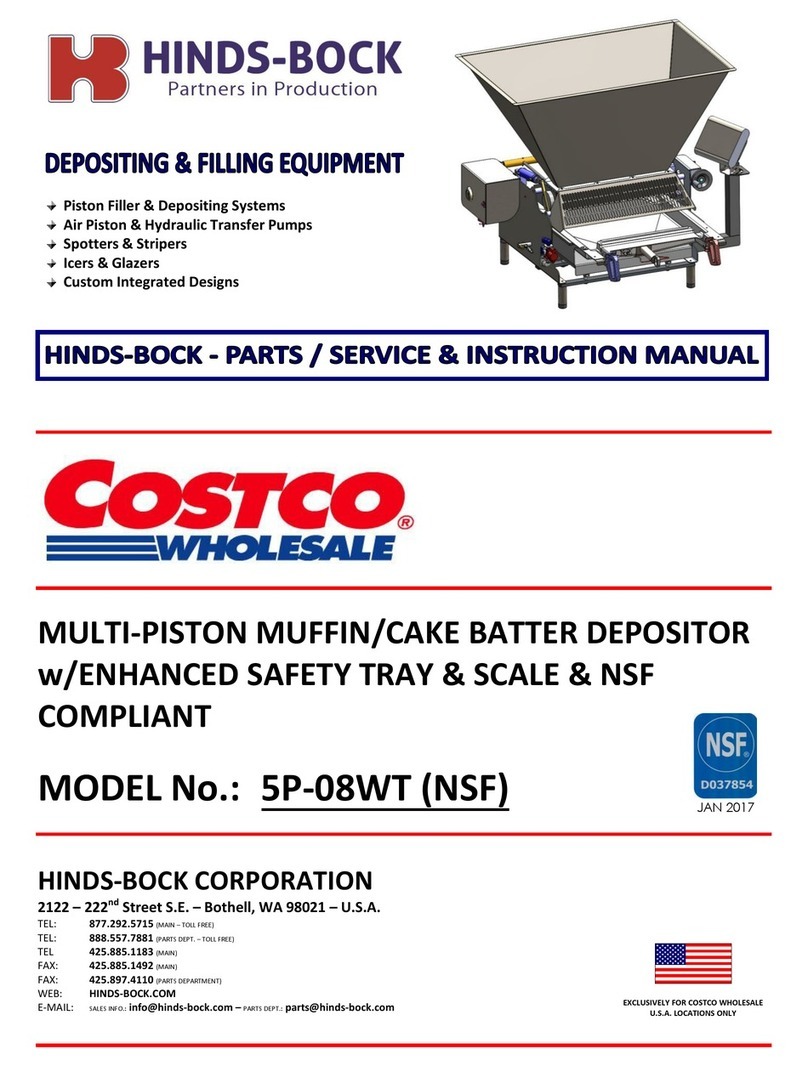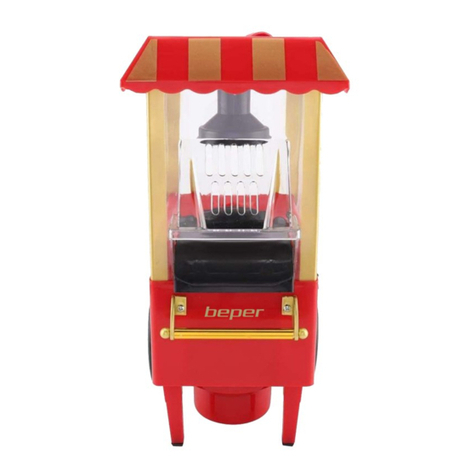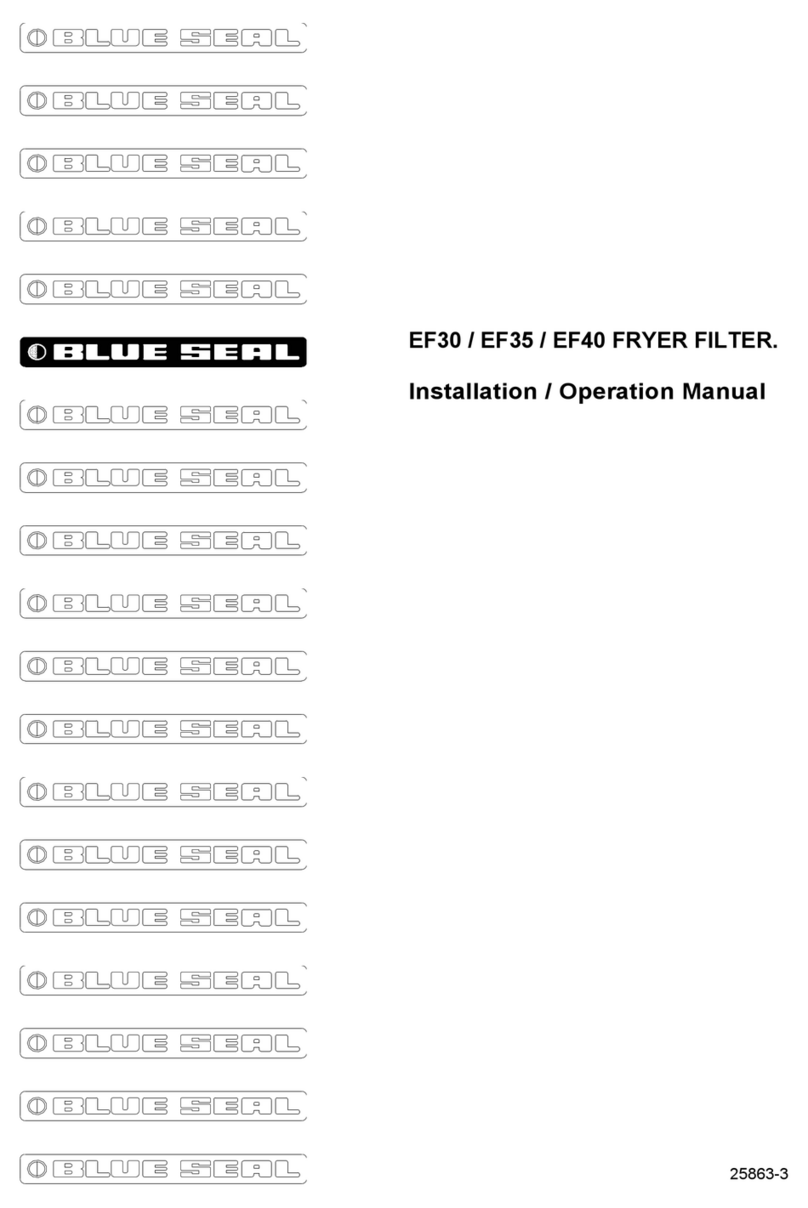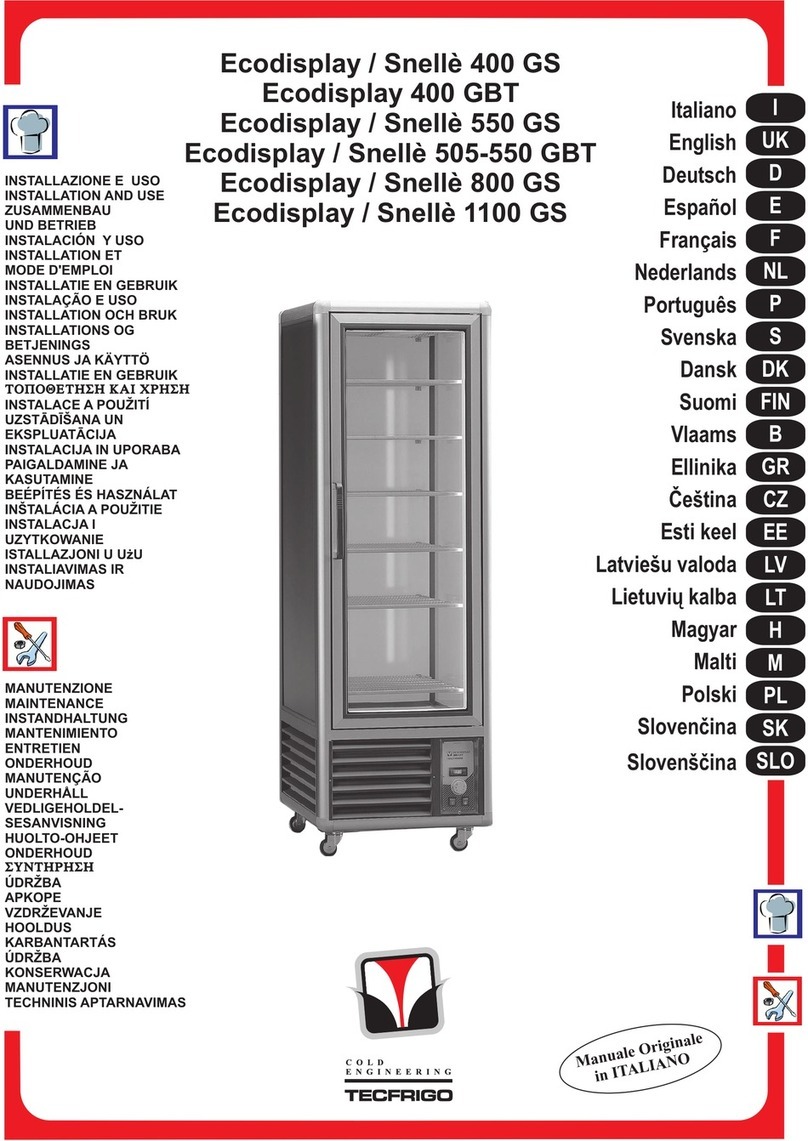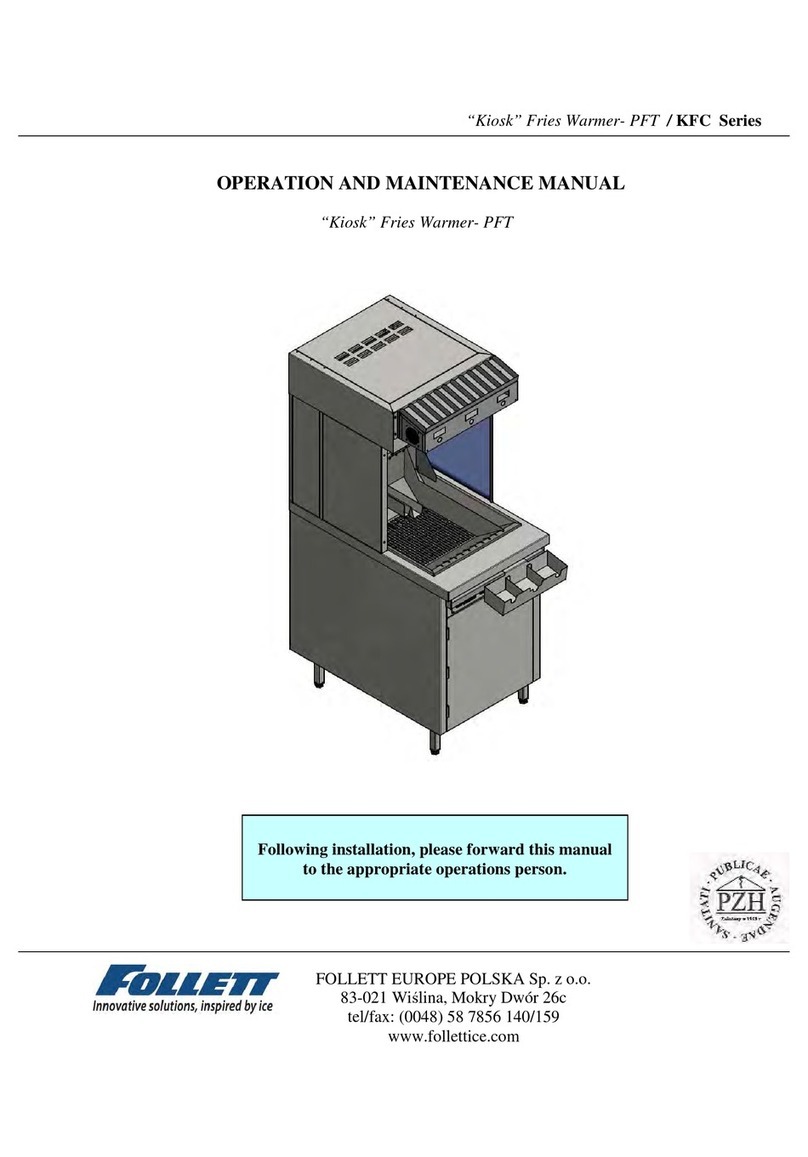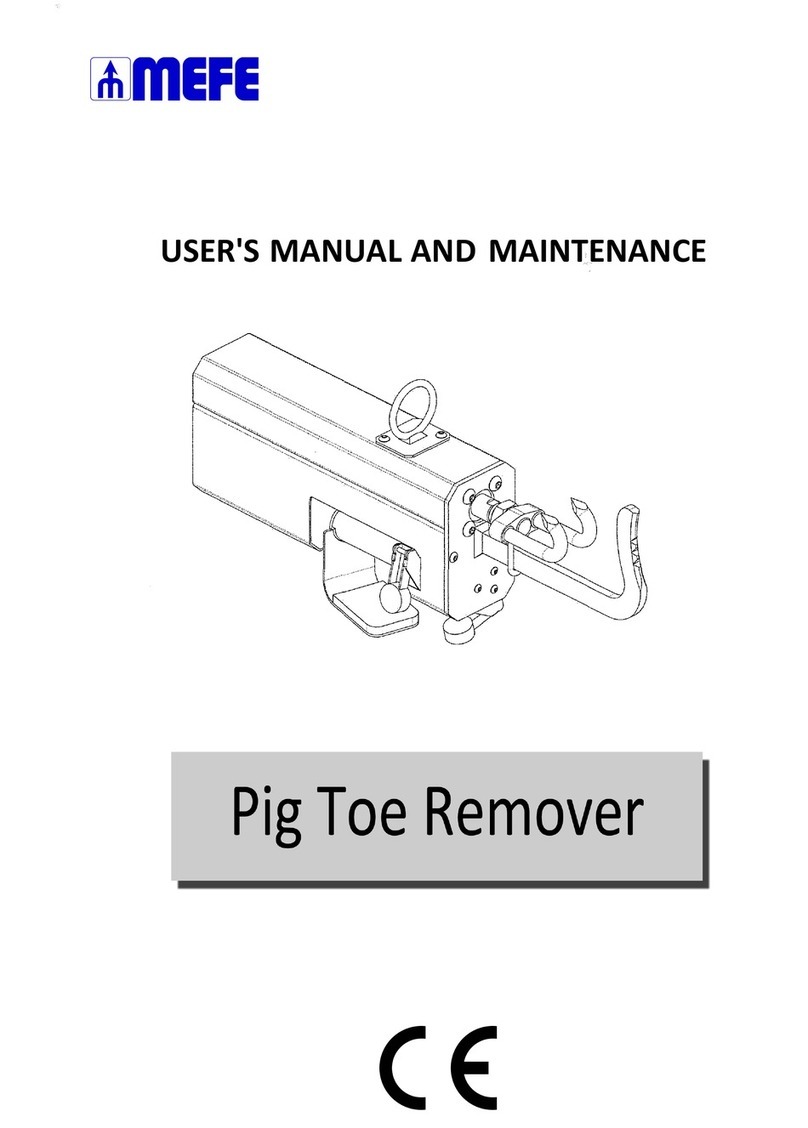CHEFOOK AS.003 Instructions for use

1
BLAST CHILLER AND DEEP FREEZER
OPERATING INSTRUCTIONS AND MAINTENANCE
MODELS:
AS.003 / AS.005C / AS.005 / AS.007 / AS.010 / AS.014.40 / AS.014 / ASW10.50 / ASW10.80 /
AS.020.80 / AS.020.100 / ASW20.100 / ASW20.170 / ASW20.200 / ASW40.200
INDEX
PAGE
1.
GENERAL INFORMATION 2
1.1. SPECIFICATIONS OF THE BLAST CHILLER-DEEP FREEZER 2
1.2. WARNINGS - SAFETY MEASURES 2
1.3. TRANSPORT AND TRANSFER 2
1.4. UNPACKING 2
2.
INSTALLATION 3
2.1. DATA PANEL (OR OPERATING SPECIFICATIONS) 3
2.2. AMBIENT CONDITIONS 3
2.3. POSITION 3
2.4. CONNECTION TO THE ELECTRIC NETWORK 3
2.5. CONNECTION TO THE REFRIGERATING UNIT (ARRANGED WITH REMOTE UNIT) 4
2.6. WATER CONNECTION (FOR WATER CONDENSED MODELS) 4
3.
OPTIMIZATION OF THE WORKING CYCLES 5
4.
ORDINARY MAINTENANCE 5
4.1. WARNINGS 5
4.2. CLEANING 5
4.3. CLEANING OF THE CONDENSER 6
5.
EXTRAORDINARY MAINTENANCE 6
6.
DISMANTLING OF THE MACHINE 6
MANUALE DI USO E MANUTENZIONE PER
ABBATTITORI - SURGELATORI RAPIDI DI TEMPERATURA
MODELLI:
AS.003 / AS.005C / AS.005 / AS.007 / AS.010 / AS.014.40 / AS.014 / ASW10.50 / ASW10.80 /
AS.020.80 / AS.020.100 / ASW20.100 / ASW20.170 / ASW20.200 / ASW40.200
INDICE
PAG.
1.
AVVERTENZE GENERALI 7
1.1. CARATTERISTICHE DELL’ABBATTITORE 7
1.2. MISURE DI SICUREZZA - INFORMAZIONI IMPORTANTI 7
1.3. TRASPORTO E MOVIMENTAZIONE 7
1.4. DISIMBALLO 7
2.
INSTALLAZIONE 8
2.1. DATI DI TARGA (O DI FUNZIONAMENTO) 8
2.2. CONDIZIONI AMBIENTALI 8
2.3. POSIZIONAMENTO 8
2.4. ALLACCIAMENTO ELETTRICO 8
2.5. ALLACCIAMENTO FRIGORIFERO (PREDISPOSTI CON GRUPPO REMOTO) 9
2.6. ALLACCIAMENTO IDRICO (PER CONDENSATI AD ACQUA) 9
3.
OTTIMIZZAZIONE DEI CICLI DI LAVORO 10
4.
MANUTENZIONE ORDINARIA 10
4.1. AVVERTENZE 10
4.2. PULIZIA 10
4.3. PULIZIA CONDENSATORE 11
5.
MANUTENZIONE STRAORDINARIA 11
6.
SMALTIMENTO DELLA MACCHINA 11

2
1.
GENERAL INFORMATION
1.1.
SPECIFICATIONS OF THE BLAST CHILLER-DEEP FREEZER
This manual contains the instructions for the correct installation, use and maintenance of your blast chiller-deep freezer and should always follow the
machine and be passed on to any future owner.
Please carefully read following instructions before starting any operation, so as to avoid any hazards to people or things and to obtain the best
performance from this appliance.
This manual should be kept in a safe place, accessible to all authorized people: the installer, the user, the person in charge for maintenance and
dismantling.
The use of the blast chiller is reserved to professionals and qualified personnel only. Keep children away and make sure they do not play with it or
touch the control board. This unit is designed to blast chill food only. Any other use is considered improper and dangerous.
1.2.
WARNINGS -SAFETY MEASURES
The manufacturer shall not be liable for any damages to people or things which are caused by improper installation and use.
Following operations are therefore strictly forbidden:
The installation and maintenance carried out by non-specialized or non-authorized personnel.
The installation of the unit carried out incorrectly, without following the manufacturer’s instructions.
Use by untrained personnel.
Non authorized modifications or technical interventions.
The removal of protection and security devices.
The connection to non-approved appliances.
The use of non-original accessories and spare parts.
The alteration by unauthorized personnel.
The carrying out of any modifications in the appliance.
Touching the appliance with wet hands or feet.
Placing any kitchen tools or other instruments between the fan blades and suction grills.
Before starting any cleaning or maintenance operations, always switch the blast chiller off and take the plug off the socket, taking care not to pull the
cable.
Make sure that the cable is not squashed or pulled during transport or installation.
The plug must always be disconnected in case the unit is not used for a long period.
The technician in charge for installation is expected to respect all prescriptions concerning: hygienic and sanitary regulations, fire and accident
regulations and all norms concerning electrical supply.
Do not introduce any explosive gases and liquids in the machine, e.g. gas for lighters, petrol, ether, acetone or others.
The blast chiller is not a refrigerated cabinet.
As soon as the working cycles are over, the unit turns automatically into a temporary – and transitional - conservation phase. At the end of the cycle,
the product is to be stored in an appropriate refrigerator.
As deep-freezing of foodstuff is regulated by law, a qualifying license issued by the Local Health Authority is needed.
Regulation (EC) no. 842/2006.
The blast chillers-deep freezers containing 3 kg or more of refrigerant gas (see table at p. 20) must be checked for leakage at least once a year. The
operators of the blast chillers-deep freezers must maintain records of the quantity of gas installed and the quantity possibly added or reclaimed during
servicing, reparation and final disposal.
1.3.
TRANSPORT AND TRANSFER
The transfer of the blast chiller should be carried out by using an electric or manual fork-lifter and be lifted from the bottom. Remove the drip tray
placed under the unit (if previously placed under it).
Make sure that the lifter capacity is higher than the weight of the blast chiller. This information is reported on the packing label and on the data
panel on the side of the unit.
Lift the unit and make sure that it's kept in stable balance.
If the unit is shipped on a truck, fasten it to the sides of the truck body through a fixing cable.
It is recommended to keep the blast chiller very close to the ground during transfers – the maximum allowed lifting height is 10 cm.
If the unit is to be lifted higher, it should be placed on a wooden platform and lifted jointly.
The weight of the unit is not to be underestimated: its size and volume might be deceiving.
Do not turn the unit upside down or lean it on its sides, so as to prevent severe damage to the structure.
If not placed in a wooden cage or on a platform, the unit can be lifted through cables.
The use of gloves is always recommended when handling the unit and its packaging.
1.4.
UNPACKING
Remove the cartons and the polystyrene, lift the unit (see par. 1.3) by a suitable means, remove the wooden platform and place the blast chiller on
the floor near the installation site. Check the integrity of the unit and ensure that it has not been damaged during shipment. If any damage should
have occurred, it has to be immediately reported to the supplier.
Keep the packaging away from children: the plastic wrapping may cause suffocation.
Use protective gloves while executing these operations.
Dispose packaging appropriately by taking it to the local recycling centre.

3
2. INSTALLATION
2.1. DATA PANEL (OR OPERATING SPECIFICATIONS)
Make sure that the operating parameters indicated on the data panel (V tension, Hz frequency, kW electrical power) comply with the ones of the
installation site.
The data panel, with information and characteristics of the unit, is applied on the left side of the unit. Models AS.003, AS.005C and AS.005ST have it
on the back side.
2.2. AMBIENT CONDITIONS
The operating temperature range for air cooled units lies between +10°C and +32°C. If the temperature exceeds these limits the declared output
and performances can be compromised and critical conditions may cause the intervention of the security switch (or security devices).
It is therefore recommended not to place the unit next to any source of heat or expose it to direct sunlight. The least clearances indicated in the next
2 paragraphs should be respected.
2.3. POSITION
Place the blast chiller in the selected position and provide to keep at least 10 cm from the back wall (see p. 19/20) and enough space in the front
side for air intake. The blast chillers equipped with remote unit should be installed following the indications mentioned in the previous
section (2.2), thus avoiding to place them next to any source of heat, even other compressor units or heat pumps.
The unit must lay on a flat, steady and firm ground, so as to provide stability to all four corners and should not lean against other appliances.
The legs can be adjusted manually or with a proper spanner for models AS.003.
The blast chiller lowers.
The blast chiller lifts up.
Slide the drip tray (optional in mod. AS.003) along the runners placed in the front bottom of the unit.
If the blast chiller is not correctly leveled, its functioning and condensation flow may be compromised.
In the roll-in units the condensation drain should be kept free at least 20 mm from the nearby drain.
Remove the protective film and clean the machine inside and outside, using protective gloves. Wash the unit inside using a light detergent, avoiding
the use of steel wool, abrasive sponges, solvents or any other products which might corrode or scratch the surfaces.
2.4. CONNECTION TO THE ELECTRIC NETWORK
The electric connection is to be carried out through the supply cable coming out at the back of the unit. For roll-in models the instructions
mentioned in the attached technical specifications must be respected. The cable is never to be pulled or damaged (danger of electrical accident). A
damaged electrical cable must be immediately replaced by a qualified and authorized electrician.
The blast chiller is to be connected to an inter-blocked plug with an effective ground wiring. The machine is non-operational only when the plug is
not plugged into the socket.
Install a safety switch of 30 mA on the electric supply board to grant protection for people. Make sure that the ground system is properly connected
with the clamp (PE) through a cable with a minimum section of 16 mm2.
Provide the coordination against contact tensions, equipotential connection, through the clamp identified by the symbol .
Make sure that the voltage (V) and frequency (Hz) correspond to the ones indicated on the data panel.
Before connecting the cable to the power point, the machine needs to be positioned upright for at least thirty minutes; four hours waiting time are
needed if the unit was transported laid on its side. The liquid of the refrigerating system needs some time to stabilize, otherwise the compressor may
be damaged.

4
2.5.
CONNECTION TO THE REFRIGERATING UNIT (ARRANGED WITH REMOTE UNIT)
The installation of blast chillers with remote compressor unit must always be carried out in compliance with the regulations concerning the prevention
of accidents, regulation and obligations of electric norms, noise and environmental impact. The possible installation of a compressor unit in a closed
room (e.g. machines room), must be carried out in compliance with the regulations in force in the country of installation. It is very important to consider
that in particular circumstances, for example in case of improper functioning, an escape of refrigerating gas can occur through the security valve or
fuse cap installed in the refrigerating unit: it is therefore necessary to provide immediate air circulation and start first aid measures as indicated on the
refrigerant security label.
The performances are guaranteed for the installation of the remote unit at a maximum distance of 10 meters.
The dimensions of the pipes must comply with the ones indicated in the table. The insulation of the air suction pipes must be at least 13 mm thick and
be made of a material suitable for refrigeration circuits.
Different installation levels between the blast chiller and its compressor unit need particular arrangements to ensure the faultless operation of the unit:
compressor unit installed higher than the blast chiller: install a syphon at each rise and any further rise, all 2 meters gradient along the
suction pipe;
unit installed lower than the blast chiller: no syphons are needed, the pipe inclination towards the compressor unit should be respected, at
least 3mm/mt.
Gas proof soldering must be executed and the pipes must be emptied through both service taps. Check for eventual leaks, turn on the taps in the
compressor unit and add gas R452A, if necessary, checking the liquid sign. Add oil, type Artic 32 synthetic, if necessary, checking the oil warning sign
(where present).
A = Minimum distance from wall 1mt
B = Remote unit
C = To be executed about every 2mt
D = Inlet and suction pipes
E = 3mm/mt gradient towards remote unit
F = Blast chiller – deep freezer
In case it were necessary to add gas
during installation, the quantity of gas
added must be marked as “PLUS” and
“TOTAL” on the label featured in
picture.
2.6.
WATER CONNECTION (FOR WATER CONDENSED MODELS)
Connect the water flow-in pipe as well as the drainpipe, as indicated on the plate on the back of the unit. Use network water with minimum pressure
of 100 kPa and a maximum of 500 kPa. The water temperature shall not exceed +18°C.
Do not use sea water. The specific models are available upon request.
Install a tap on the entrance pipe. The water drain must be in free air at least 20 mm from the nearby drain.
With still unit check for any water leakage from the drainpipe. If this were the case, slightly turn the pressure valve off ( ¼ of a turn).
Attention! The missing water flow will cause the block of the unit and the activation of the security switch HP.
Minimum distance between water drain and floor or other surface.
A Suction B Inlet
AS.005 / AS.007 Ø 12mm Ø 8mm
AS.010 / AS.014.40 Ø 16mm Ø 12mm
AS.014 / ASW10.50 /
ASW10.80
Ø 22mm Ø 16mm
AS.020.80 Ø 28mm Ø 16mm
AS.020.100 / ASW20.100 /
ASW20.170 Ø 35mm Ø 16mm
ASW20.200 / ASW40.200 Ø 42mm Ø 16mm

5
3. OPTIMIZATION OF THE WORKING CYCLES
PRE-COOLING: Pre-cool the unit before starting a chilling or deep-freezing cycle, so as to reduce the working times.
CORE PROBE: The core probe must be properly positioned at the core of the thickest part of the product. Its point shall neither come out nor
touch the tray. The probe must be cleaned before starting any cycle, in order to prevent any contamination.
LIDS AND CONTAINERS: Do not cover the trays and/or containers with lids or insulating films. The more the product surface gets in contact
with the airflow, the less it will take to chill and deep-freeze it. Do not use bowls or trays deeper than 40 mm.
DISTRIBUTION OF THE PRODUCT: Do not lay portions of product upon each other. The product thickness must not exceed 50 mm: this
would make the chilling / freezing times longer. Do not overload the unit beyond the quantity recommended by the manufacturer.
SPACE BETWEEN THE TRAYS: Allow enough space between the trays in order to grant a proper airflow. Place them evenly inside the unit.
CONSERVATION: At the end of the cycle the chilled and/or frozen product must be covered and protected (film, airtight, hermetic sealing).The
chilled product needs to be conserved in a storage refrigerator at a uniform temperature of +2°C. The frozen product is to be conserved in a
storage refrigerator at a uniform temperature of -20°C.
Mark the containers of the chilled/frozen product with an appropriate label, clearly indicating content and expiry date.
The blast chiller is not a refrigerated cabinet.
As soon as the working cycles are over, the unit turns automatically into a temporary – and transitional -conservation phase. At the end of
the cycle, the product is to be stored in an appropriate refrigerator.
4. ORDINARY MAINTENANCE
4.1. WARNINGS
Carefully read all security and warning instructions in the introduction page.
The manufacturer is not liable for any damages caused by improper operations or by any improper use of the appliance, as from the specifications of
this instruction manual.
It is necessary to remind users about some basic operations to be carried out before starting cleaning:
Disconnect the machine from the electrical feeding network unplugging the main switch and the feeding plug.
Use protective gloves to protect the hands.
Do not introduce any tools, screwdrivers or other instruments between the moving parts or the protection elements.
Do not pierce pipes, or open the gas valves.
Do not pull the feeding cable.
Do not remove protective and security devices while carrying out ordinary maintenance operations.
ATTENTION: it is important to keep the electronic controller cleaned so as to grant its correct functioning. It is recommend to clean with
frequency the control panel using a non abrasive dry or damp cloth.
4.2. CLEANING
The machine must be cleaned either inside and outside before starting any working cycle and at the end of any cycle
, thus preventing the
arising of germs, bacteria, virus and unpleasant smells – together with anything else that may harm food.
The machine must be cleaned using degreasing and disinfectant products commonly used in the kitchen. Avoid steel wool, abrasive sponges,
solvents and any products, which might corrode or scratch the surfaces.
Avoid detergents based on chlorine, chloride and ammonia, they could cause corrosion to the surfaces.
Use basic detergents.
In short, the blast chiller must be clean when used and must be left clean at the end of every working session.
The racks are easily removable for cleaning. Reposition them once they have been washed.
It is important to carefully wash the inside of the unit and the door.
Do not scrape with sharp tools, especially the cool generator.
Remove the drain cap on the bottom of the chamber to let the water flow out and put it back before starting a new working cycle. The waste water
will be drained into the drip tray (optional in mod. AS.003), which will be emptied and cleaned every day by pulling it out from the front bottom of
the unit.
Wipe off any remaining water with a clean cloth.
Keep the door half open, so as to allow air circulation inside the chamber and prevent bad smells and mould from developing.
Prevent any salt pouring on the surfaces of the blast chiller: if this should occur, clean the surface properly and immediately.

6
4.3. CLEANING OF THE CONDENSER
The condenser needs to be cleaned at least all 2 months. In the air cooled models, the condenser is placed on the front side of the unit, whereas the
models equipped with remote unit have the condenser in the group itself. This important operation ensures the proper functioning of the unit and
avoids the intervention of the security switch (HP).
Put protective gloves on to carry out these operations: the condenser tongues are very sharp. Also use protective glasses and a protection mask for
the respiratory tract.
The appliance counts the functioning hours executed by the user and it periodically shows the CH alarm (see par. 8.4) that signals the necessity to
clean the condenser.
Carefully follow the instructions listed here below:
Disconnect the plug from the power point before starting;
For AS.003, AS.005C and AS.005ST models extract the filter situated on the frontal side of the appliance. Turn the locking devise 90° counter
clockwise and remove the filter from the lower side;
On all other models strongly pull the front panel;
Turn the board carefully over in order to prevent damages to the control board;
Clean the condenser by removing all dust and down deposits, using a brush or aspirator along the wings, making sure not to bend them; in
case of greasy deposits, remove them by using a little brush dipped in alcohol;
Once finished, close the front panel;
Roll-in units have the condenser is at sight.
5. EXTRAORDINARY MAINTENANCE
All operations of extraordinary maintenance must be carried out by specialized personnel only, authorized to operate on electric and refrigerating
parts. The following section gives indications and suggestions on how to manage and solve possible breakdowns or functioning problems.
Contact our dealers for service, always reporting model and serial number indicated on the specification plate attached on the left side of the unit.
Original spare parts are available at our Technical Service Centres only.
6. DISMANTLING OF THE MACHINE
The dismantling of the machine should be carried out respecting following warnings: unplug the unit from the power point and cut the feeding cable
as much near as possible to the unit. Take the doors away and keep children away from the unit, take care not to damage the refrigerating system
inside or in the back. The blast chiller does not contain any harmful substance for the ozone layer. The refrigerant gas is indicated on the plate outside
the unit.
This product is projected and manufactured with high quality materials and components, which can be recycled and reused.
The symbol of a crossed bin with wheels applied on the product means that the product complies with the European Directive 2002/95/EC.
You are required to get all information on this subject at your local recycling centre.

7
1. AVVERTENZE GENERALI
1.1. CARATTERISTICHE DELL’ABBATTITORE
Questo manuale contiene le istruzioni per l’installazione, l’uso e la manutenzione dell’abbattitore e deve sempre accompagnare l’apparecchio anche
nel caso in cui questo cambi proprietario.
Prima di attivare qualsiasi operazione leggere attentamente le istruzioni, evitando così rischi alle cose e alle persone. Si otterrà un funzionamento
ottimale dell’apparecchio, sfruttandone al massimo le possibilità di resa.
Il manuale deve essere conservato in un luogo ben accessibile a tutti gli autorizzati: l’installatore, l’utilizzatore, il responsabile della manutenzione e
dello smaltimento.
L’utilizzo dell’abbattitore è riservato esclusivamente a realtà professionali e a personale qualificato. Tenere l’abbattitore fuori dalla portata dei bambini:
assicuratevi che non venga usato come un gioco e che non vengano toccati i comandi. La macchina è destinata esclusivamente all’uso per il quale è
stata concepita cioè l’abbattimento rapido della temperatura degli alimenti. Qualsiasi altro uso è da considerarsi non conforme e pericoloso.
1.2. MISURE DI SICUREZZA - INFORMAZIONI IMPORTANTI
Il costruttore declina ogni responsabilità per eventuali danni a persone e cose causati da installazione e uso improprio.
Sono quindi rigorosamente vietati:
L’installazione e la manutenzione da parte di personale non specializzato e autorizzato.
L’installazione della macchina in maniera impropria senza seguire le istruzioni.
L’uso da parte di personale non addestrato.
Modifiche o interventi tecnici non autorizzati.
La rimozione di dispositivi di protezione e sicurezza.
Il collegamento ad apparecchiature non autorizzate
L’uso di accessori e ricambi non originali.
La manomissione da parte di personale non autorizzato.
Apportare modifiche alla macchina.
Toccare la macchina con mani o piedi bagnati.
Inserire utensili da cucina o altro tra le protezioni dei ventilatori o griglie di aspirazione.
Prima di qualsiasi operazione di pulizia e manutenzione spegnere sempre l’abbattitore e togliere la spina dalla presa, facendo attenzione ad estrarre
la spina senza tirare il cavo.
In fase di installazione o trasporto fare attenzione che il cavo non resti schiacciato e che non sia in tensione.
In caso di soste prolungate o di non utilizzo dell’abbattitore disinserire sempre la spina di alimentazione elettrica.
L’installatore è tenuto ad osservare le prescrizioni inerenti a: norme igienico sanitarie, norme in materia di antincendio, norme antinfortunistiche,
disposizioni di fornitura elettrica.
Non introdurre nell’apparecchio gas o liquidi esplosivi, come gas per accendini, benzina, etere, acetone, o simili.
L’abbattitore non è un conservatore.
Una volta terminati i cicli di lavoro, l’abbattitore passa automaticamente in conservazione, che deve essere però intesa come temporanea, ossia di
transizione. A fine ciclo il prodotto andrà quindi riposto in un armadio frigorifero / conservatore dedicato.
La legge limita la possibilità di surgelare o congelare alimenti in proprio subordinandola al rilascio di un permesso abilitativo da parte
dell’USSL o altro ente preposto di competenza.
Regolamento (CE) n.842/2006.
Gli abbattitori contenenti 3 kg o più di gas refrigerante (vedi tabella pag. 20) devono essere controllati per individuare perdite di gas almeno una volta
all’anno. Gli operatori degli abbattitori hanno l’obbligo di tenere un registro in cui riportano la quantità di gas installato e la quantità eventualmente
aggiunta o recuperata durante le operazioni di manutenzione, di riparazione e di smaltimento definitivo.
1.3. TRASPORTO E MOVIMENTAZIONE
Il trasporto dell’abbattitore deve essere effettuato tramite un carrello elevatore elettrico o manuale, o transpallet, sollevando la parte inferiore del
fondo, con l’avvertenza di togliere prima dell’operazione la vaschetta raccogli condensa posta sul fondo della macchina stessa (se precedentemente
posizionata).
Accertarsi che la portata del mezzo di sollevamento sia superiore al peso della macchina indicato nella targhetta dell’imballo e nella targhetta di
identificazione applicata alla macchina.
Dare corso al sollevamento assicurandosi che l’apparecchio sia in stabile equilibrio.
Nel caso di trasporto tramite automezzo assicurare la macchina mediante fune di fissaggio ai lati del cassone.
E’ opportuno quindi effettuare spostamenti mantenendo la macchina sempre vicinissima al suolo: il massimo sollevamento consentito è di 10 cm.
Per sollevamenti a quote superiori è opportuno poggiare la macchina su di una pedana in legno e sollevarla congiuntamente.
Non sottovalutare il peso dell’apparecchio: le dimensioni ed il volume della macchina possono trarre in inganno.
Non capovolgere o appoggiare sui lati la macchina stessa onde evitare gravi danni alla struttura.
La macchina, se sprovvista di gabbia in legno o pedana, è sollevabile mediante funi.
Usare sempre guanti protettivi nel maneggiare la macchina e l’imballo.
1.4. DISIMBALLO
Togliere l'imballo in cartone e polistirolo, sollevare l'apparecchio (vedi par. 1.3) con un mezzo adeguato e togliere la pedana in legno, appoggiare
l'apparecchio a terra in prossimità del luogo destinato all'installazione. Verificare l'integrità della macchina e che non abbia subito danni durante il
trasporto, nel qual caso verranno tempestivamente comunicati al fornitore.
Tenere l'imballo fuori dalla portata dei bambini: la pellicola trasparente può comportare il rischio di soffocamento.
Durante queste operazioni usare sempre guanti protettivi.
Conferire l'imballo al preposto centro di raccolta e riciclaggio.

8
2. INSTALLAZIONE
2.1. DATI DI TARGA (O DI FUNZIONAMENTO)
E’ di assoluta importanza verificare che i dati di targa di funzionamento (V tensione, Hz frequenza, kW potenza elettrica) siano in linea con quelli del
luogo di installazione.
La targa con i dati e le caratteristiche della macchina si trovano sul lato sinistro della stessa. Nei modelli AS.003, AS.005C e AS.005ST è collocata
nella parte posteriore.
2.2. CONDIZIONI AMBIENTALI
Per le macchine condensate ad aria il campo di lavoro dovrà rientrare nei seguenti valori di temperatura: +10°C e +32°C. Il superamento del limite
massimo può compromettere prestazioni e rese dichiarate e in condizioni critiche provoca l’intervento del pressostato di sicurezza (o dei dispositivi
di sicurezza).
Pertanto bisogna evitare l’installazione della macchina in prossimità di qualsiasi fonte di calore o l’esposizione della stessa all’irraggiamento solare
diretto. Rispettare le distanze minime di posizionamento indicate nei due paragrafi successivi.
2.3. POSIZIONAMENTO
Collocare la macchina nella posizione prevista. Mantenere una distanza di almeno 10 cm dalla parete di fondo (vedi pag. 19/20) e garantire frontalmente
lo spazio per l’aspirazione dell’aria. Per le macchine con i gruppi compressori remoti, installare i gruppi rispettando le indicazioni del paragrafo
precedente (2.2), evitando perciò di posizionare i gruppi in prossimità di fonti di calore, anche in prossimità di altri gruppi
compressori o pompe di calore.
La macchina deve poggiare su di un pavimento piano, stabile e di consistente resistenza, per garantire la stabilità su tutti e quattro gli angoli ed è
importante che non sia appoggiata ad altre macchine.
I piedini si registrano manualmente o con apposita chiave nei modelli AS.003.
L’abbattitore si abbassa. L’abbattitore si alza.
Inserire la vaschetta raccogli - condensa (nel modello AS.003 è optional) nella parte frontale in basso facendola scorrere lungo le apposite guide.
Se l’abbattitore non è correttamente livellato, il funzionamento e il deflusso delle condense possono essere compromessi.
Nelle macchine a carrello collegare lo scarico condense in aria libera ad almeno 20 mm dallo scarico contiguo.
Rimuovere integralmente la pellicola protettiva e pulire la macchina esternamente ed internamente utilizzando guanti protettivi. Lavare l’interno della
macchina con un detersivo ad azione leggera evitando l’uso di pagliette di ferro, spugne abrasive, solventi ed altri prodotti che possano corrodere o
graffiare le superfici.
2.4. ALLACCIAMENTO ELETTRICO
Il collegamento elettrico va effettuato nella parte retrostante, tramite il cavo di alimentazione che fuoriesce posteriormente. Nei modelli a carrello
rispettare le indicazioni dell’allegata scheda tecnica. Accertarsi che il cavo di alimentazione non sia mai in trazione e non sia danneggiato (pericolo di
infortunio elettrico). Un cavo di alimentazione danneggiato deve essere sostituito immediatamente da un centro di assistenza, nella persona di un
elettricista qualificato autorizzato.
L’abbattitore va collegato ad una presa interbloccata dotata di efficace messa a terra. La macchina è priva di tensione elettrica solamente quando la
spina di alimentazione è staccata dalla presa.
Sul quadro elettrico di alimentazione deve essere installato un interruttore magnetotermico differenziale da 30 mA per la protezione delle persone.
Assicurarsi dell’esistenza del collegamento all’impianto di terra al morsetto (PE) con cavo di sez. minima di 16 mm2.
Predisporre il coordinamento contro le tensioni di contatto, collegamento equipotenziale, tramite il morsetto con indicato il simbolo .
Accertarsi che la tensione (V) e la frequenza (Hz) di rete corrispondano a quella indicata nella targhetta di identificazione.
Prima di dare tensione alla macchina è necessario che questa stia in posizione verticale per almeno trenta minuti; occorre invece aspettare circa
quattro ore se la macchina è stata trasportata in posizione orizzontale. Il liquido del sistema refrigerante deve infatti avere il tempo di stabilizzarsi,
altrimenti il compressore rischia di guastarsi.

9
2.5.
ALLACCIAMENTO FRIGORIFERO (PREDISPOSTI CON GRUPPO REMOTO)
L’installazione di macchine con gruppo compressore remoto deve essere effettuata sempre nel rispetto delle normative in materia di: norme
antinfortunistiche, disposizioni e vincoli delle norme elettriche, nonché di impatto ambientale e di rumore aereo prodotto. L’eventuale installazione
del gruppo compressore in ambienti chiusi (tipo sale macchine), richiede il rispetto delle norme vigenti nel paese di installazione. E’ da tenere presente
che in condizioni particolari, come ad esempio nel caso di anomalie di funzionamento, può verificarsi un rilascio di gas refrigerante nell’ambiente
tramite la valvola di sicurezza o tappo fusibile installate nell’impianto frigorifero: è quindi necessario provvedere ad un idoneo ricambio d’aria e
intervenire con misure di primo soccorso come indicato nella scheda di sicurezza del refrigerante.
Le rese sono garantite per l’installazione del gruppo remoto a una distanza massima di 10 mt.
Le dimensioni dei tubi devono corrispondere a quelle indicate in tabella. L’isolamento dei tubi di aspirazione deve avere uno spessore di almeno 13
mm con materiale idoneo per circuiti di refrigerazione.
L’installazione a livelli diversi tra l’abbattitore e il gruppo compressore comporta degli accorgimenti molto importanti per il buon funzionamento
dell’abbattitore:
gruppo installato più in alto rispetto all’abbattitore: un’operazione indispensabile da effettuare in questo caso è quella di inserire un
sifone a ogni partenza o risalita ad ogni 2 mt. di dislivello lungo il percorso sul tubo di aspirazione;
gruppo installato più in basso rispetto all’abbattitore: non è necessario inserire i sifoni, rispettare le pendenze dei tubi verso il gruppo
compressore, almeno 3mm/mt.
Eseguire saldature ermetiche, fare il vuoto dei tubi, tramite i due rubinetti di servizio. Controllare eventuali perdite, aprire i rubinetti sul gruppo
compressore. Rabboccare di gas R452A, se necessario, controllando la spia di liquido. Rabboccare con olio di tipo Artic 32 sintetico, se necessario,
controllando la spia olio (dove presente).
A = Distanza minima muro di 1mt
B = Gruppo remoto
C = Da eseguire ogni 2mt circa
D = Tubi mandata e aspirazione
E = Pendenza di 3mm/mt verso gruppo remoto
F = Abbattitore
Nel caso dovesse essere necessario in
fase di installazione aggiungere del gas
refrigerante bisogna riportare
nell’etichetta di figura il quantitativo di
gas aggiunto “PLUS” e il totale
“TOTAL”.
2.6.
ALLACCIAMENTO IDRICO (PER CONDENSATI AD ACQUA)
Collegare il tubo di mandata acqua e il tubo di uscita come indicato nella targhetta posta sulla parte posteriore. Utilizzare acqua di rete con
pressione minima 100 kPa e massimo 500 kPa ed una temperatura non superiore a +18°C.
Non utilizzare acqua di mare, chiedere nell’eventualità i modelli idonei.
Installare una saracinesca sul tubo di ingresso. Lo scarico dell’acqua deve essere in aria libera ad almeno 20 mm dallo scarico contiguo.
Controllare a macchina ferma che non ci sia fuoriuscita d’acqua dal tubo di uscita, in caso contrario chiudere leggermente ( ¼ di giro ) la valvola
pressostatica.
Attenzione! La mancanza di acqua in ingresso porta il blocco della macchina con l’intervento del pressostato di sicurezza HP.
Distanza minima tra scarico acqua e pavimento o altra superficie.
A Aspirazione B Mandata
AS.005 / AS.007 Ø 12mm Ø 8mm
AS.010 / AS.014.40 Ø 16mm Ø 12mm
AS.014 / ASW10.50 /
ASW10.80
Ø 22mm Ø 16mm
AS.020.80 Ø 28mm Ø 16mm
AS.020.100 / ASW20.100 /
ASW20.170 Ø 35mm Ø 16mm
ASW20.200 / ASW40.200 Ø 42mm Ø 16mm

10
3. OTTIMIZZAZIONE DEI CICLI DI LAVORO
PRERAFFREDDAMENTO: Prima di eseguire un ciclo di abbattimento o surgelazione è indispensabile preraffreddare la camera al fine di ridurre
i tempi di lavoro.
SONDA AL CUORE: La sonda deve essere posizionata in modo corretto, al cuore del prodotto e nel punto più spesso. La punta non deve mai
fuoriuscire o toccare la teglia. La sonda deve essere pulita prima di ogni ciclo, al fine di evitare contaminazioni.
COPERCHI E CONTENITORI: Non coprire le teglie e/o i contenitori con coperchi o pellicole isolanti. Più la superficie del prodotto è a contatto
con l’aria in circolo nella camera, più rapidi risulteranno l’abbattimento e la surgelazione. Sono vivamente sconsigliate vaschette o teglie con
profondità superiori a 40 mm.
DISTRIBUZIONE DEL PRODOTTO: Non sovrapporre mai il prodotto e verificare comunque che non ci siano spessori superiori a 50 mm che
comporterebbero un prolungamento dei tempi di abbattimento e surgelazione. Non sovraccaricare la macchina oltre la resa stabilita dal
costruttore.
SPAZIO TRA I RIPIANI: Mantenere un interspazio sufficiente tra le teglie per consentire un’adeguata circolazione dell’aria. Evitare la
concentrazione delle teglie su una parte della macchina e distribuirle uniformemente.
CONSERVAZIONE: Alla fine del ciclo il prodotto abbattuto e/o congelato deve essere coperto e protetto (pellicola, sottovuoto, coperchio
ermetico). Se il prodotto è stato semplicemente abbattuto, deve essere conservato ad una temperatura costante di +2°C in un armadio frigorifero.
Se invece è stato sottoposto ad un ciclo di surgelazione, il prodotto va conservato in un armadio frigorifero ad una temperatura costante di -20°C.
Contraddistinguere il contenitore in cui si conserva il prodotto abbattuto/surgelato con un apposito cartellino in cui siano riportati i dati sul
contenuto e la data di scadenza.
L’abbattitore non è un conservatore.
Una volta terminati i cicli di lavoro, l’abbattitore passa automaticamente in conservazione, che deve essere però intesa come temporanea,
ossia di transizione. A fine ciclo il prodotto andrà quindi riposto in un armadio frigorifero / conservatore dedicato.
4. MANUTENZIONE ORDINARIA
4.1. AVVERTENZE
Leggere attentamente le disposizioni di sicurezza e le avvertenze riportate all’inizio del manuale.
Il produttore non si assume alcuna responsabilità per danni causati da operazioni scorrette o da un qualunque uso improprio della macchina,
secondo quanto specificato nel presente manuale d’uso.
E’ indispensabile ricordare alcune operazione fondamentali prima di procedere alla pulizia:
Scollegare la macchina dalla rete di alimentazione elettrica disinserendo l’interruttore generale e staccando la spina di alimentazione.
Utilizzare guanti protettivi per proteggere le mani.
Non introdurre utensili o cacciaviti o altro tra le parti in movimento o protezione.
Non forare le tubazioni né aprire valvoline del gas.
Non mettere in trazione il cavo di alimentazione.
Non rimuovere protezioni e dispositivi di sicurezza effettuando operazioni di manutenzione ordinaria.
ATTENZIONE: è importante mantenere pulito il pannello di comando per garantirne il corretto funzionamento. Si raccomanda di pulire
con frequenza il controllore utilizzando panni asciutti o umidi non abrasivi.
4.2. PULIZIA
La macchina deve essere pulita nel suo interno ed esterno sia prima di iniziare il ciclo di lavoro, sia alla fine di ogni ciclo di lavoro
,
evitando in questo modo che nell’ambiente interno si sviluppino germi, batteri, virus, cattivi odori e quant’altro possa compromettere la qualità dei
prodotti alimentari.
La macchina deve essere pulita con prodotti sgrassanti e disinfettanti utilizzati in cucina, evitando l’uso di pagliette di ferro, spugne abrasive, solventi
ed altri prodotti che possono corrodere o graffiare la superficie.
Evitare detergenti a base di cloro, cloride e ammoniaca, potrebbero causare corrosioni alle superfici.
Usare detergenti basici.
Riassumendo, la macchina va utilizzata pulita e alla fine del lavoro va lasciata pulita.
I supporti porta-teglie sono facilmente estraibili per la pulizia, una volta lavati, riapplicarli.
E’ importante sciacquare bene tutto l’interno della macchina e la parte interna della porta.
Non raschiare con corpi appuntiti, specialmente la parte del generatore del freddo.
Per scaricare l’acqua di lavaggio togliere il tappo sul fondo della vasca e reinserirlo nello scarico prima di iniziare un nuovo ciclo di lavoro. L’acqua di
lavaggio finirà sulla vaschetta raccogli condensa (nei mod. AS.003 la vaschetta è optional) che dovrà essere svuotata e pulita giornalmente,
estraendola dalla parte frontale della macchina.
Asciugare eventuali residui di acqua rimasti con un panno pulito.
Lasciare la porta socchiusa affinché circoli l’aria all’interno della camera, evitando così la formazione di muffe e cattivi odori.
Evitare qualsiasi operazione che comporti il deposito di sale da cucina sulle superfici dell’abbattitore: se questo dovesse verificarsi pulire
subito accuratamente.

11
4.3. PULIZIA CONDENSATORE
La pulizia del condensatore deve essere fatta almeno ogni 2 mesi. Per i modelli condensati ad aria il condensatore è collocato nella parte
anteriore della macchina, mentre nei modelli con gruppo compressore remoto, il condensatore si trova nel gruppo stesso. Questa importante
operazione garantisce un corretto funzionamento della macchina, evitando l’intervento del pressostato di sicurezza (HP).
Le operazioni di pulizia devono essere effettuate indossando guanti protettivi, perché le alette del condensatore sono particolarmente taglienti.
Usare inoltre occhiali e mascherina di protezione delle vie respiratorie.
L’apparecchio esegue costantemente il conteggio delle ore di ciclo eseguite dall’utente e periodicamente fa comparire automaticamente l’allarme
CH (vedi par. 8.4), che segnala la necessità di effettuare la pulizia del condensatore.
Seguire con attenzione le seguenti istruzioni:
Togliere la spina dalla presa di alimentazione prima di iniziare l’operazione;
Nel caso del modello AS.003, AS.005C e AS.005ST estrarre il filtro collocato nella parte anteriore della macchina, girare il fermo in senso
antiorario di 90°, sfilare il filtro dalla parte inferiore;
Per tutti gli altri modelli tirare con forza il pannello anteriore della macchina;
Ribaltare il pannello con cautela per evitare rotture alla scheda di comando;
Pulire il condensatore rimuovendo i depositi di polvere e lanugine, con una spazzola o un aspiratore, con un movimento lungo la direzione delle
alette facendo attenzione a non piegarle. In caso di presenza di depositi untuosi eliminarli usando un pennello imbevuto di alcol;
Una volta ultimata la pulizia richiudere bene il pannello;
Nei modelli con gruppo remoto il condensatore è a vista.
5. MANUTENZIONE STRAORDINARIA
Gli interventi di manutenzione straordinaria possono essere eseguiti solo da personale specializzato, autorizzato a intervenire su parti elettriche e
parti frigorifere. Nel capitolo seguente è riportata una tabella con indicazioni e suggerimenti per la gestione e soluzione di eventuali guasti o
problemi / inconvenienti di funzionamento.
Per l’assistenza tecnica rivolgersi ai nostri rivenditori comunicando il modello dell’abbattitore e il numero di matricola, indicati sulla targhetta dati,
posta sul fianco SX della macchina stessa.
I ricambi originali si trovano solo presso i nostri centri di assistenza tecnica.
6. SMALTIMENTO DELLA MACCHINA
Lo smaltimento dell’abbattitore deve avvenire rispettando le seguenti precauzioni: togliere la spina dalla presa di corrente e di seguito tagliare il cavo
di alimentazione il più vicino possibile all’apparecchio. Togliere le porte e tenere l’apparecchio fuori dalla portata dei bambini. Attenzione a non
danneggiare il sistema di refrigerazione all’interno e sul retro. L’apparecchio non contiene alcuna sostanza nociva per lo strato di ozono. Il refrigerante
è indicato sulla targhetta all’esterno dell’apparecchio.
Questo prodotto è stato progettato e fabbricato con materiali e componenti di alta qualità, che possono essere riciclati e riutilizzati.
Il simbolo del bidone con ruote barrato da una croce, applicato su tutti i modelli, sta ad indicare che il prodotto è conforme alla Direttiva Europea
2002/95/EC.
Si prega di informarsi in merito presso il locale centro di raccolta differenziata.

12
WARRANTY
Warranty of proper functioning.
SINOFCOLD S.r.l. warrants for the proper functioning of the appliance, object of this sale, for a period of twelve months starting from purchase date to the original purchaser, not to successive purchasers.
The warranty hereto provides for the replacement of faulty parts returned ex-works, workmanship excluded. The replacement of the parts within the warranty period does not prolong the same warranty. The purchaser has no compensation
rights for damages due to the misuse of the machine.
The warranty is not applicable in the following cases:
•If the purchaser does not comply with the terms of payment;
•If damages are due to unskilled, unconventional use, overloading, poor care, tampering or modifications which were not authorized by the manufacturer, lack of or unstable power supply;
•If damages are due to an accidental case or force majeure;
•If the defects are not made known to SINOFCOLD S.r.l. in writing within eight days from their discovery, causing the loss of its effectiveness;
•If the notification does not include the detailed description of the claimed defect as well as its possiblecauses;
This warranty is not applicable to ordinary wear and tear of the machine.
SINOFCOLD S.r.l. does not accept responsibility for the quality of the products obtained from the machine since this depends on different factors such as: the skilfulness and technique of the operator, quality and quantities of the ingredients
or materials used.
In the event that the notification is accepted, SINOFCOLD S.r.l. will replace those parts of the unit that are found damaged or faulty, on condition that the malfunction is due to production defects.
In the event that the notification is not accepted, SINOFCOLD S.r.l. reserves the right to hold this warranty valid, thus making known this intention - on pain of ineffectiveness, in writing (fax is admitted) or by phone, within five days from
receipt
of the notification.
For the applicability of this warranty, the existence of a production defect is left to the exclusive technical assessment of SINOFCOLD S.r.l., which will avail itself of its own or trusted personnel.
The warranty of proper function does not cover defects due to improper use of the product by the purchaser.
The warranty of proper functioning does not include (and therefore the corresponding expenses are paid by the purchaser):
•cleaning actions;
•any intervention work carried out to repair the unit when the unit could be repaired by the purchaser himself according to the instruction manual;
•any ordinary maintenance intervention needed for the normal use of the unit;
•any intervention carried out to remove damages due to power circuit failure or to causes related to the professional, commercial and industrial activity performed by the purchaser;
•any action performed to repair functioning defects due to bad maintenance of the unit by the purchaser or third parties appointed by the purchaser, or in the case that the maintenance was not performed according to the provisions
given by SINOFCOLD S.r.l.;
•any action performed to remove functioning defects due to abuses of the unit by the purchaser or third parties;
•any interventions aimed at repairing the faults caused by damages to the unit due to transport of the appliance from the headquarters of SINOFCOLD S.r.l. to its destination.
The warranty hereto does not cover damages incurred by the purchaser due to non-use of the unit.
GARANZIA
Garanzia di buon funzionamento.
La SINOFCOLD S.r.l. garantisce all’originario acquirente e non anche ad eventuali successivi acquirenti, il buon funzionamento della merce oggetto della presente vendita per un periodo di mesi dodici dalla data di conclusione del contratto
di compravendita.
La garanzia consiste nella sostituzione gratuita di pezzi della macchina difettosi, resi franco fabbrica, con esclusione della mano d’opera. In ogni caso la macchina non verrà sostituita. La sostituzione di pezzi durante il periodo di garanzia
non prolunga la stessa. Il compratore non ha diritto ad alcun indennizzo per eventuali danni derivanti dal fermo della macchina.
L’acquirente decade dalla garanzia se:
•non osserva le condizioni di pagamento;
•i guasti sono causati da imperizia, uso anormale, sovraccarico, cattiva manutenzione, manomissione o modifiche al macchinario, irregolarità o deficienze di fornitura di energia elettrica;
•i guasti dipendono da caso fortuito o forza maggiore;
•non denunzia per iscritto alla SINOFCOLD S.r.l. i difetti di funzionamento entro giorni otto dalla scoperta, sotto pena didecadenza;
•se la denuncia non contiene la descrizione dettagliata del lamentato difetto di funzionamento nonché delle possibili cause dello stesso.
Sono esclusi dalla garanzia il normale logorio e deperimento della macchina.
La SINOFCOLD S.r.l. non assume alcuna responsabilità relativamente alla qualità del prodotto ottenuto con la macchina in quanto dipendente da molteplici fattori quali l’abilità tecnica dell’operatore, qualità degli ingredienti, dosaggio ecc…
Qualora la denunzia sarà ritenuta efficace, la SINOFCOLD S.r.l. provvederà alla sostituzione dei pezzi dell’impianto che risulteranno avariati o difettosi, purché si tratti di un cattivo funzionamento attribuibile ad un difetto di fabbricazione.
Qualora la denunzia non sarà ritenuta efficace, la SINOFCOLD S.r.l. si riserva di ritenere operante la suddetta garanzia comunicando tale intenzione, a pena di inefficacia, per iscritto (anche via fax) o telefonicamente, nel termine di giorni
cinque dalla denunzia.
L’esistenza di un difetto di fabbricazione, ai fini dell’operatività della suddetta garanzia, è lasciato alla esclusiva valutazione tecnica della SINOFCOLD S.r.l., la quale, al riguardo, potrà avvalersi di personale dalla stessa dipendente o
comunque di sua fiducia.
La garanzia di buon funzionamento non copre i difetti causati da negligenza d’uso del prodotto da parte del compratore.
La suddetta garanzia di buon funzionamento (e pertanto le spese relative sono a carico del compratore) non comprende:
•gli interventi di pulizia dell’impianto;
•gli interventi effettuati per riparare l’impianto quando gli stessi potevano essere eseguiti dal compratore sulla basedelle istruzioni di uso;
•gli interventi di manutenzione resi necessari dall’uso cui l’impianto è destinato;
•gli interventi sull’impianto effettuati per eliminare danni provocati dal circuito elettrico o comunque da cause attinenti all’attività professionale, commerciale e industriale svolta dal compratore;
•interventi effettuati per riparare difetti di funzionamento causati da cattiva manutenzione dell’impianto effettuata dal compratore o da terzi incaricati dallo stesso, oppure a causa di manutenzione non eseguita secondo quanto prescritto
dalla SINOFCOLD S.r.l.;
•interventi effettuati per eliminare difetti di funzionamento causati da manomissioni del bene, effettuati dal compratore o daterzi;
•interventi necessari al fine di riparare i difetti di funzionamento causati dal danneggiamento dell’impianto dovuto al trasporto del bene dalla sede della SINOFCOLD S.r.l. al luogo di consegna dello stesso.
La suddetta garanzia di buon funzionamento non copre il danno subito dal compratore a causa del fermo dell’impianto.
SINOFCOLD S.r.l.
Via dell’Artigianato, 24 - 31030 Castello di Godego - Treviso - Italy
Tel. (+39) (0)423-768270 / Fax (+39) (0)423-469539
www.sinofcoldsrl.com - info@sinofcoldsrl.com
This manual suits for next models
14
Table of contents
Languages:
Other CHEFOOK Commercial Food Equipment manuals
Popular Commercial Food Equipment manuals by other brands
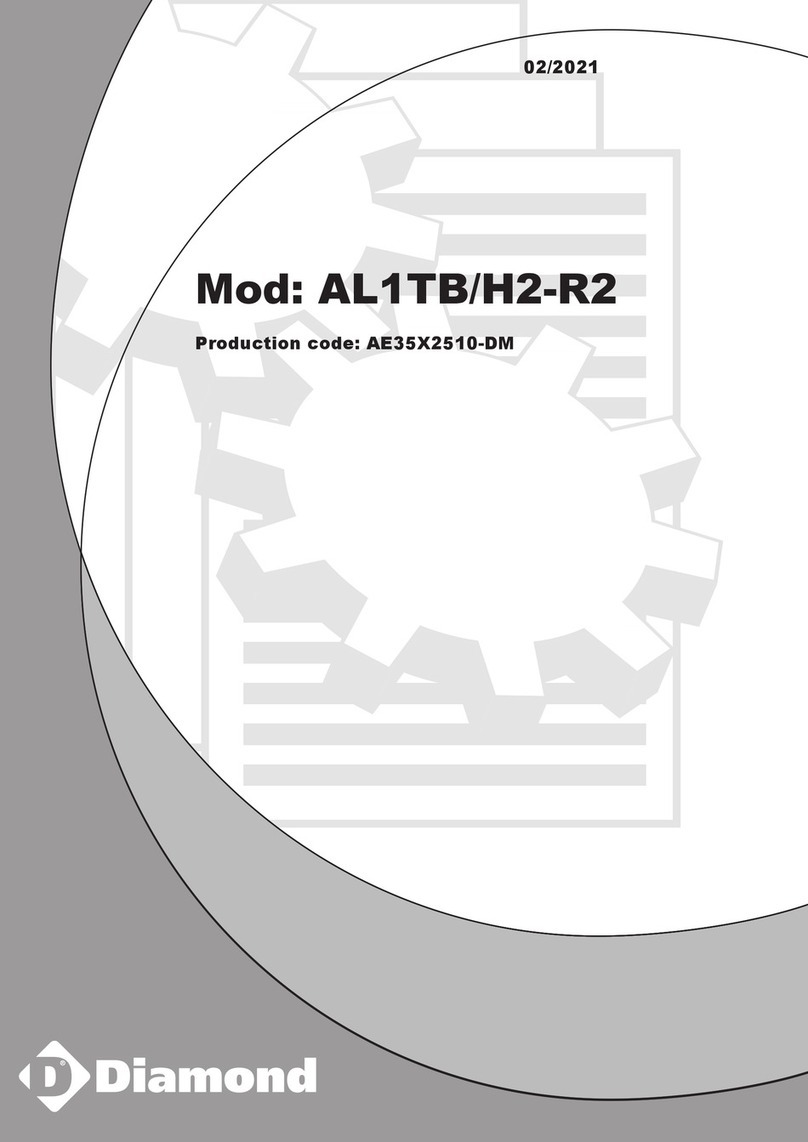
Diamond
Diamond AL1TB/H2-R2 Installation, Operating and Maintenance Instruction
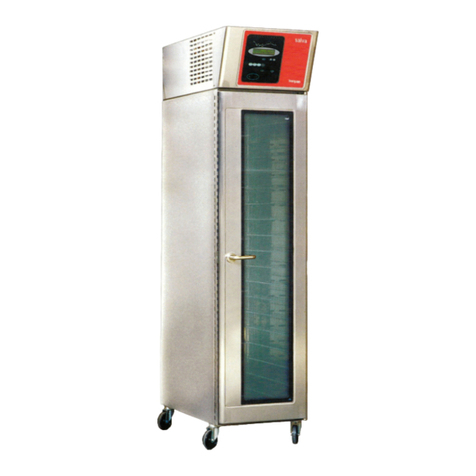
Salva
Salva IVERPAN FC-18 User instructions
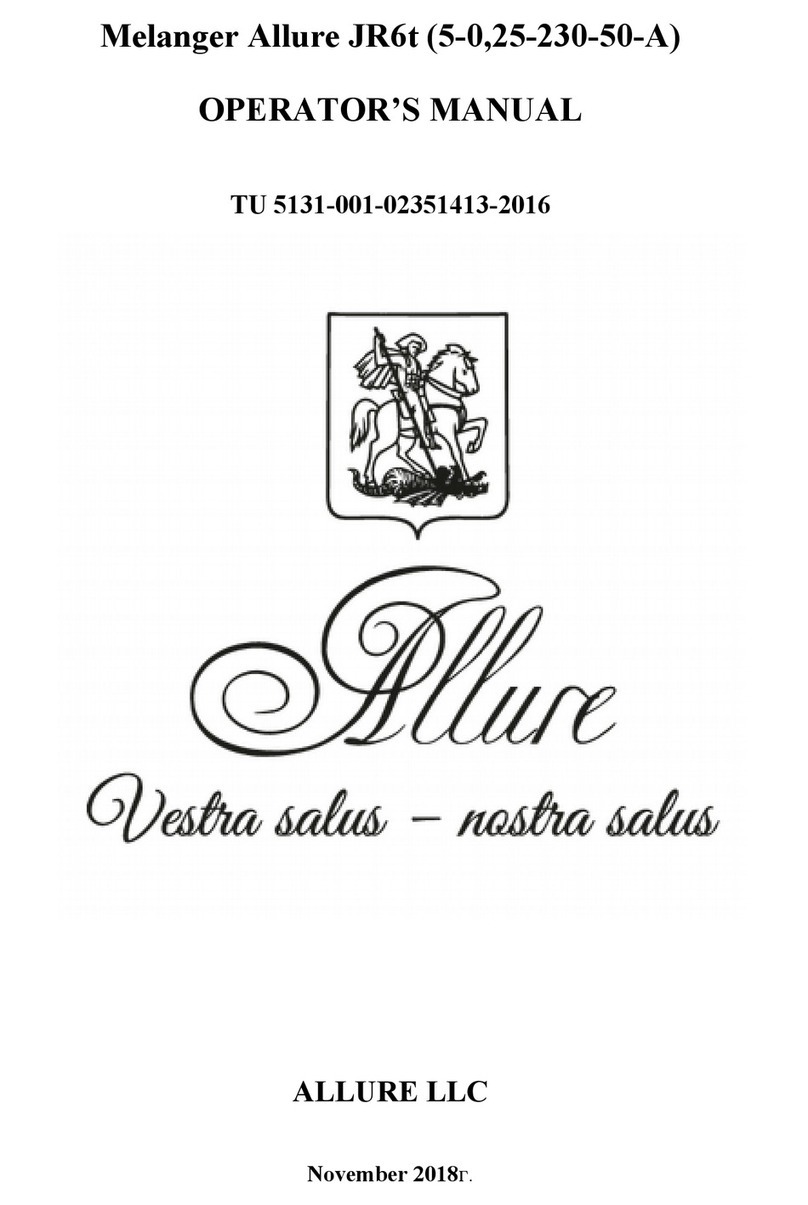
Allure
Allure Melanger JR6t Operator's manual
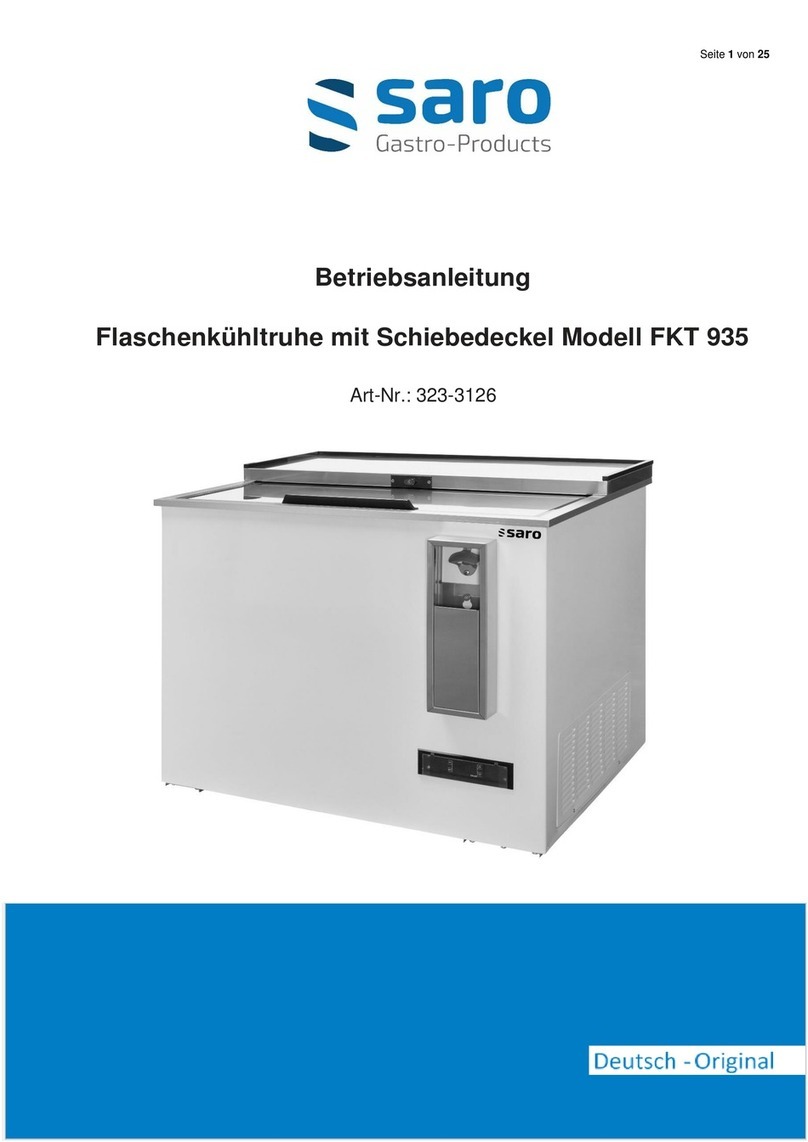
saro
saro FKT 935 operating instructions
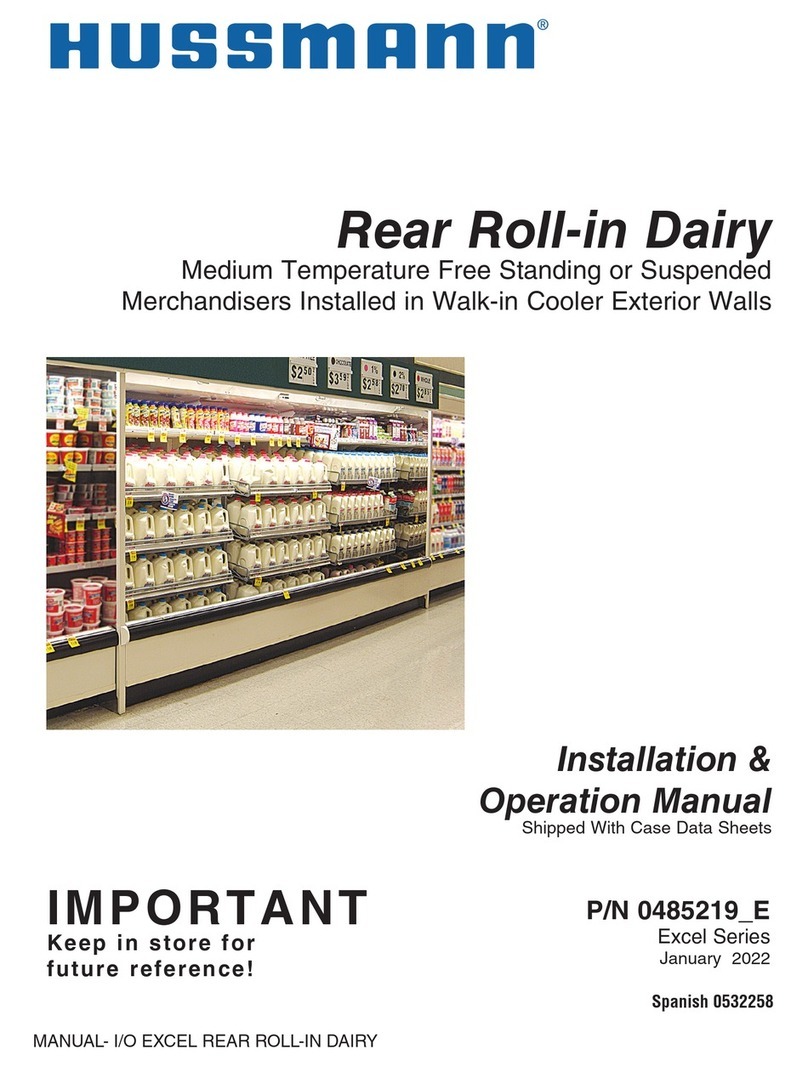
Hussmann
Hussmann Rear Roll-in Dairy Installation & operation manual
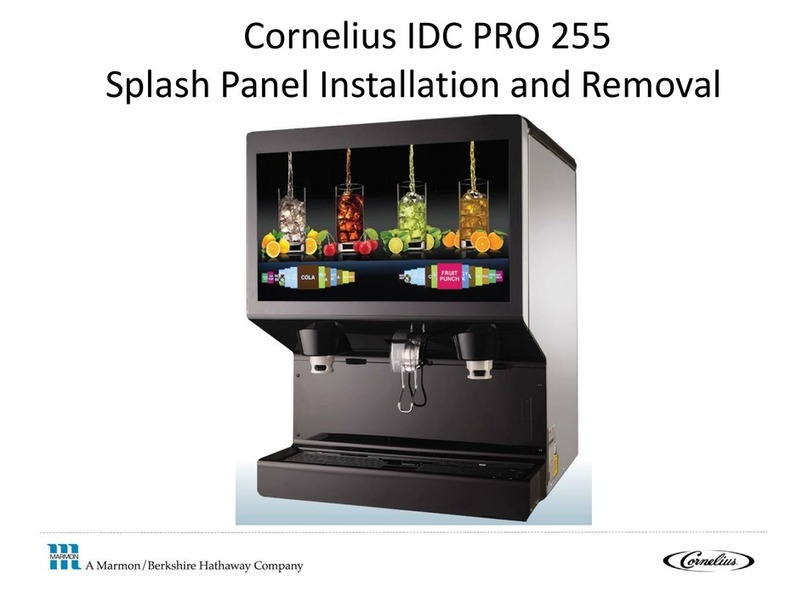
Cornelius
Cornelius IDC PRO 255 Service manual
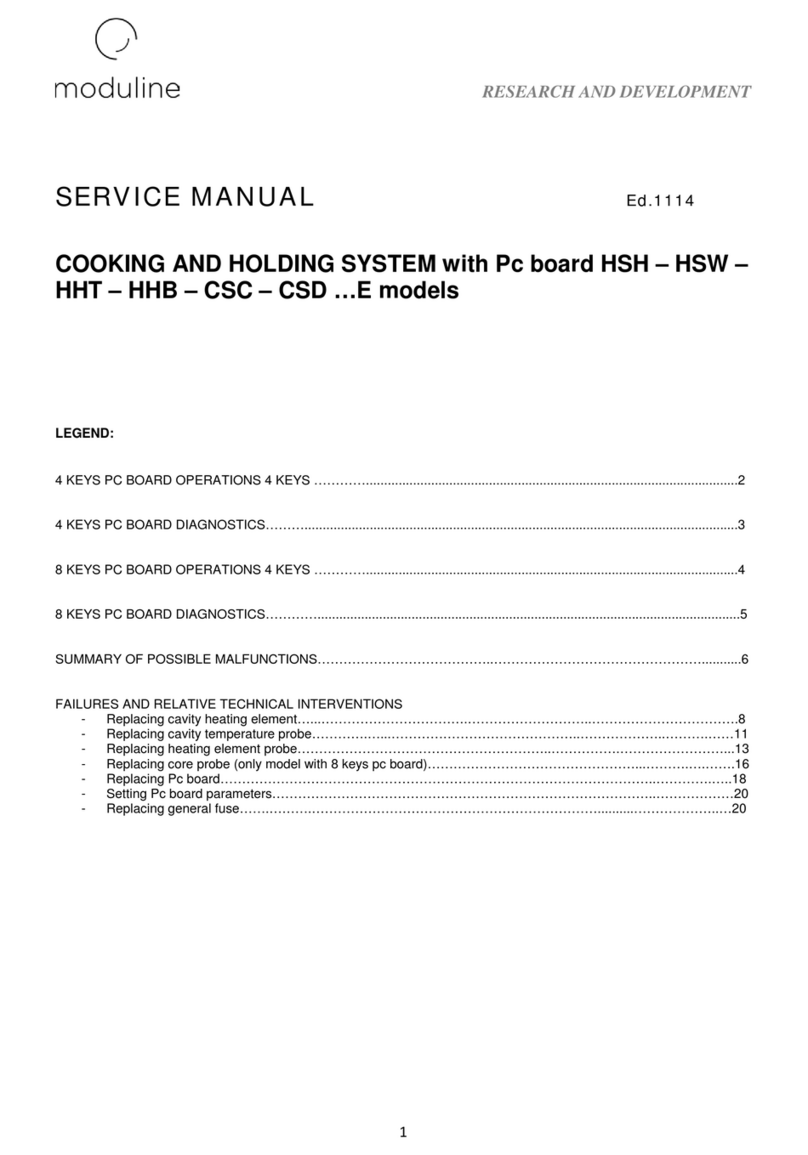
Moduline
Moduline HSH E Series Service manual
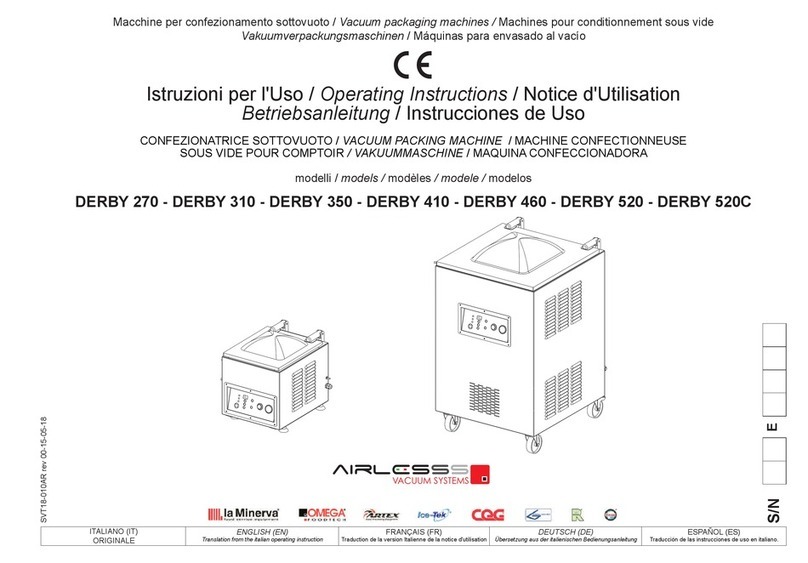
MINERVA OMEGA
MINERVA OMEGA DERBY 270 operating instructions
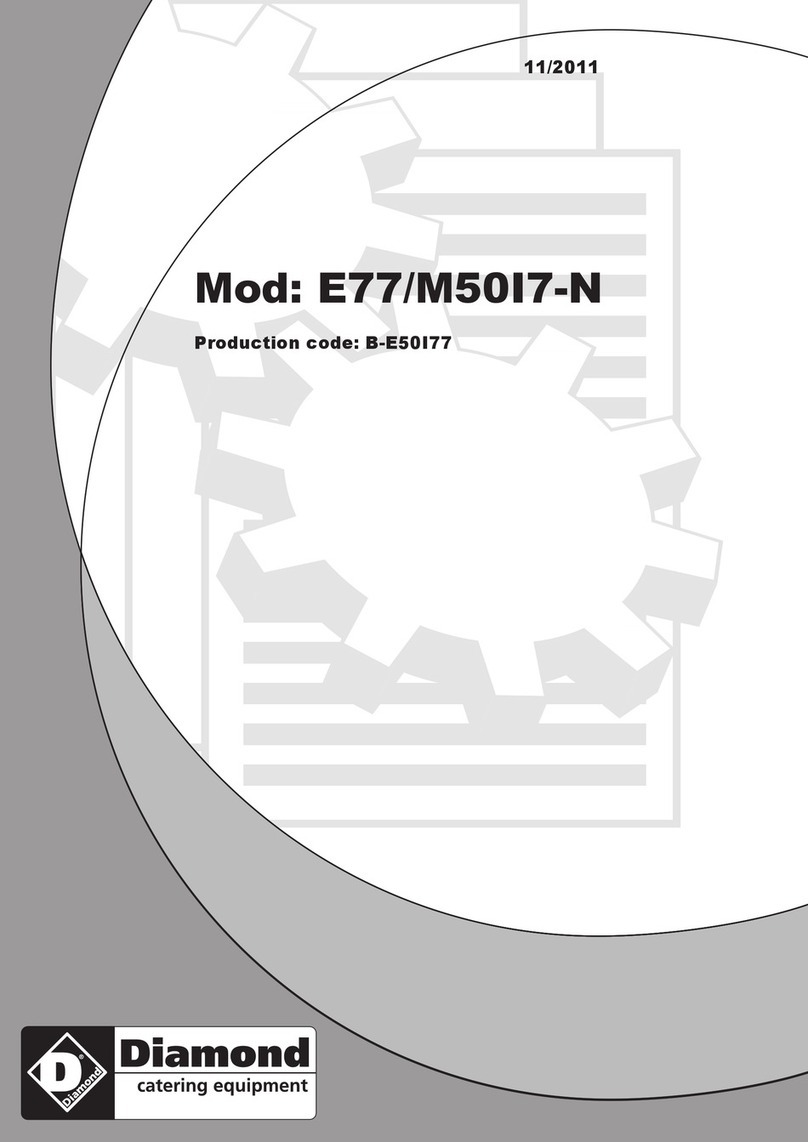
Diamond
Diamond OPTIMA 700 Installation, use and maintenance instructions
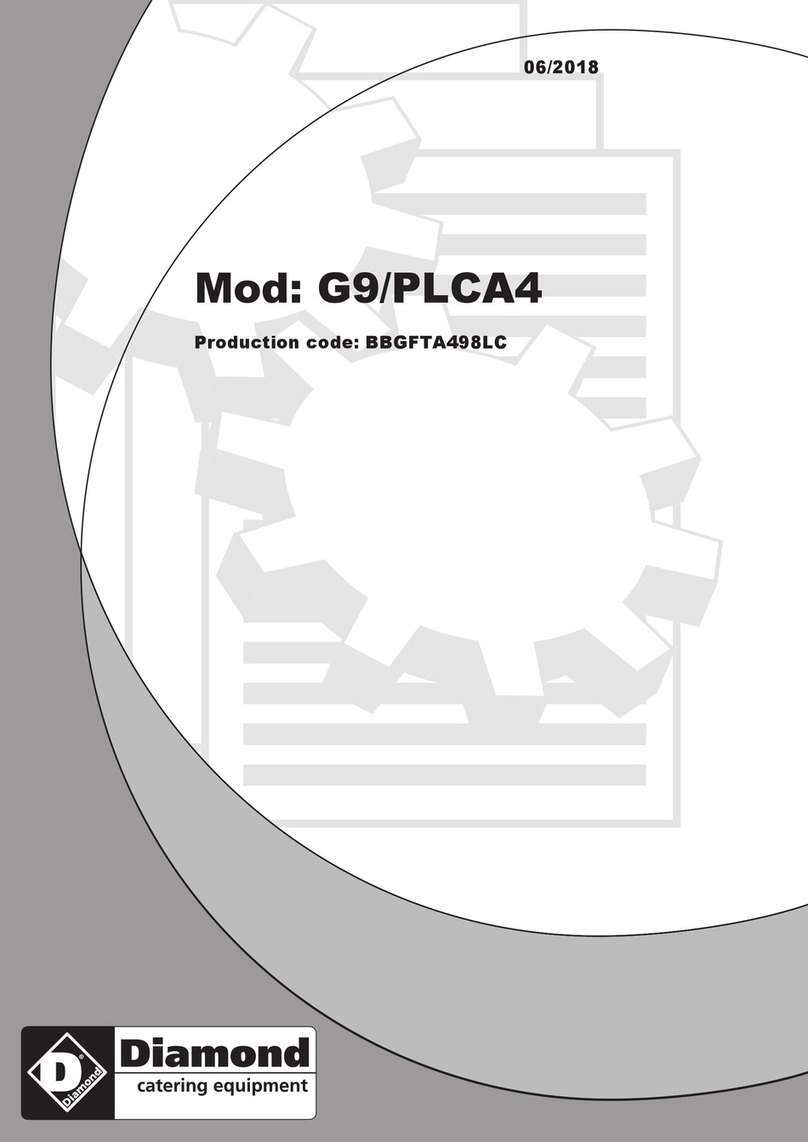
Diamond
Diamond G9/PLCA4 operating instructions
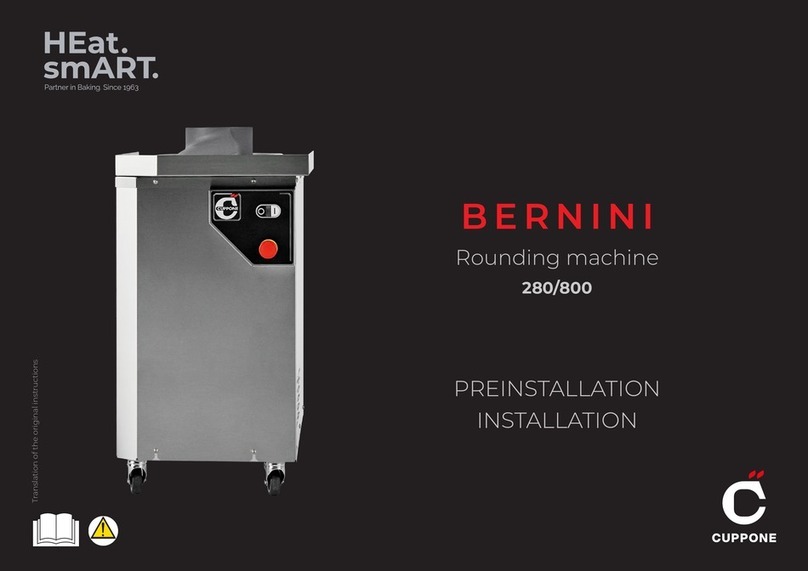
Cuppone
Cuppone BERNINI BRN 280 Installation

Arneg
Arneg Atlanta Direction for Installation and Use
